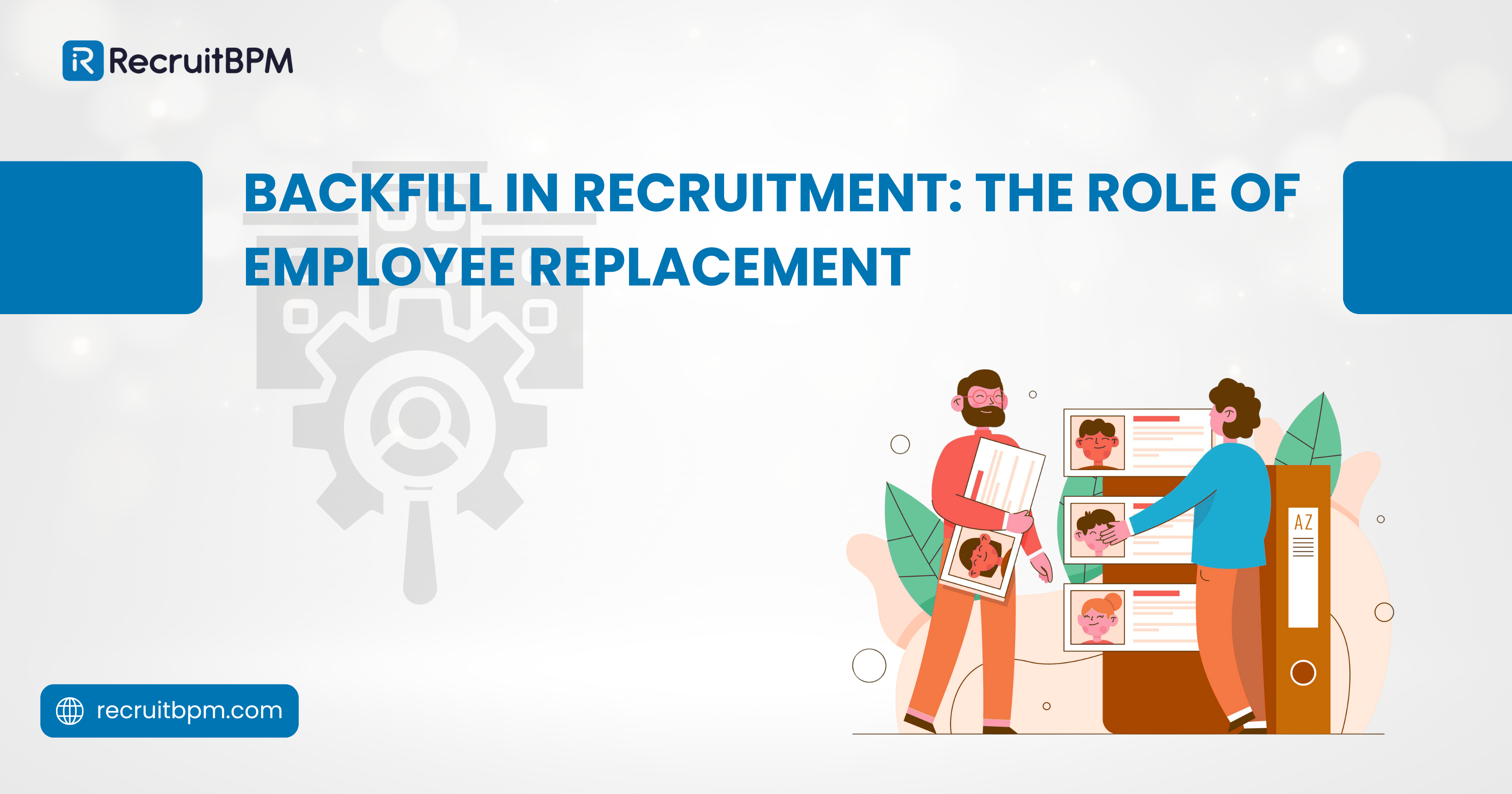Employee departures, promotions, and extended leaves create operational gaps that threaten productivity and team momentum. Organizations cannot afford to halt projects or overburden remaining staff while searching for permanent solutions. Yet traditional hiring processes move too slowly for time-sensitive coverage needs.
Backfilling addresses this fundamental workforce challenge. When employees transition internally or temporarily step away, backfill positions maintain continuity without expanding headcount. For recruitment agencies, mastering backfill placements unlocks lucrative opportunities while fostering client relationships through rapid and reliable staffing solutions.
What is Backfill?
Backfill refers to the process of filling a position vacated by a current employee who has been promoted, transferred, or is temporarily unavailable due to leave. A backfill position is a temporary or permanent role created to cover for an existing employee who is unavailable due to leave, temporary reassignment, or an internal move, such as a promotion.
The distinguishing characteristic of backfill is that it maintains the existing team structure rather than creating new roles. The goal isn’t to expand the team, but to keep things running smoothly by taking over the responsibilities of the person who has stepped away. Organizations need someone to assume specific duties immediately, ensuring workflow continuity while the original employee remains elsewhere.
Backfilling ensures uninterrupted operations, prevents disruptions, and maintains productivity by recruiting a qualified replacement for a specified period. The timeframe varies dramatically—from weeks covering parental leave to permanent placements when promoted employees never return to their original positions.
Backfill differs fundamentally from replacement hiring. Replacement positions involve hiring after permanent departures through resignation, retirement, or termination. The original employee won’t return, making the hire definitively permanent. Backfill situations maintain the possibility of the original employee’s return, though many backfills eventually convert to permanent placements when circumstances change.
Common backfill triggers include internal promotions creating vacancies in previous roles, extended medical or parental leave requiring temporary coverage, sabbaticals or educational leaves spanning months, temporary project assignments pulling employees from regular duties, and internal transfers moving talent between departments.
Why Backfill Matters for Recruitment Agencies?
Backfill placements represent a specialized recruitment niche that offers strategic advantages for agencies willing to develop expertise in rapid, targeted staffing solutions.
Urgency creates premium opportunities. Backfill needs arise unexpectedly and demand immediate attention. When key employees depart suddenly for promotions or extended leaves, client operations suffer daily delays. This urgency allows recruitment agencies to command premium fees for expedited placement services that prevent costly productivity losses.
Client relationships deepen through reliability. Organizations remember recruitment agencies that solved critical staffing emergencies. Successfully filling urgent backfill positions builds trust and credibility that translates into preferred vendor status for future hiring needs. One well-executed emergency placement often opens doors to ongoing recruitment partnerships.
Volume potential multiplies through internal mobility. Companies promoting from within create cascading backfill needs. A single executive promotion might trigger three or four downstream backfills as promoted employees leave vacancies throughout the organizational hierarchy. Recruitment agencies positioned to fill these chains capture multiple placements from single promotion decision.
Replacement costs justify investment. According to SHRM, it typically costs a company six to nine months of an employee’s salary to replace them. For someone earning $60,000 annually, that translates to $30,000 to $45,000 in recruitment and training expenses. These substantial costs motivate organizations to engage professional recruitment agencies rather than struggling with internal backfill processes.
Temporary-to-permanent conversions increase revenue. Many backfill positions initially framed as temporary eventually become permanent when original employees don’t return, accept different opportunities, or organizations realize the backfill arrangement works better than anticipated. Recruitment agencies placing candidates in temporary backfill roles often secure permanent placement fees when positions convert.
Niche expertise commands market positioning. Agencies developing reputations for rapid, quality backfill placements differentiate themselves in competitive markets. Specialization in urgent staffing needs attracts clients who value speed and reliability over lowest-cost providers.
Repeat business accelerates through proven performance. Organizations facing backfill needs once will face them repeatedly. Employees continue taking leave, accepting promotions, and transferring internally. Recruitment agencies that solve initial backfill challenges become go-to resources for future needs.
Market timing advantages emerge. Backfill opportunities don’t correlate with general hiring freezes or economic downturns the way new position creation does. Even during hiring slowdowns, internal mobility continues generating backfill needs that sustain recruitment agency revenue streams.
How to Use Backfill Effectively?
Maximizing backfill placement success requires specialized approaches that differ from traditional recruitment strategies focused on permanent new position creation.
Maintain ready talent pools segmented by role. Backfill urgency demands immediate candidate access. Build databases of pre-screened, available candidates organized by function, experience level, and availability timeline. When backfill requests arrive, you should present qualified candidates within hours rather than starting sourcing from scratch.
Develop rapid assessment processes. Traditional multi-round interview processes don’t align with backfill urgency. Create streamlined evaluation frameworks that assess candidate fit quickly without sacrificing quality. Structured phone screens, targeted skills assessments, and accelerated reference checks compress timelines while maintaining standards.
Clarify temporary versus permanent expectations early. Misaligned expectations about position duration create problems. Confirm whether organizations expect original employees to return, whether backfills might convert to permanent roles, and what triggers would cause duration changes. Transparent communication prevents candidate frustration and failed placements.
Leverage internal mobility intelligence. Track client organizational charts, promotion patterns, and succession planning discussions. Anticipating likely backfill needs before they become urgent gives your agency first-mover advantages. Proactive outreach suggesting backfill solutions before clients request them demonstrates strategic partnership.
Price services reflecting urgency value. Backfill placements solve immediate business problems that cost clients real money daily. Fee structures should reflect the premium value of rapid placement rather than treating backfill as discounted temporary staffing. Organizations facing productivity losses understand that speed has substantial worth.
Build relationships with temporary staffing networks. Some backfill situations genuinely need short-term coverage with no permanent conversion possibility. Partnerships with temporary staffing providers allow you to serve these needs without maintaining temp infrastructure yourself, preserving client relationships even when opportunities don’t fit your direct placement model.
Document institutional knowledge transfer processes. Encourage and facilitate knowledge transfer from departing employees to backfill candidates. This handover improves backfill success rates and client satisfaction. Agencies that coordinate smooth transitions add value beyond simply filling positions.
Cross-train candidates on adjacent skills. Backfill candidates with broader skill sets can cover multiple potential roles, increasing placement flexibility. Someone trained in both accounting and financial analysis can backfill either function, doubling their placement potential.
Create backfill-specific candidate pools. Some professionals prefer temporary or project-based work over permanent roles. Build dedicated pools of these candidates who welcome backfill opportunities. Consultants between engagements, semi-retired professionals, and parents seeking flexible arrangements often fit backfill needs perfectly.
Track backfill conversion rates. Monitor how frequently your temporary backfill placements convert to permanent positions. High conversion rates validate candidate quality and provide revenue forecasting data. Low conversion might indicate mismatched candidate selection or unrealistic client expectations requiring adjustment.
Common Challenges with Backfill
Despite significant opportunities, backfill placements introduce distinct challenges that recruitment agencies must navigate to achieve consistent success and client satisfaction.
Duration ambiguity creates planning difficulties. Clients often can’t specify exactly how long backfill coverage is needed. Medical leaves extend unexpectedly, promoted employees decide they prefer their original roles, or temporary assignments become permanent. This uncertainty complicates candidate recruitment—some candidates want temporary work while others seek permanent positions. Misalignment between actual duration and candidate expectations creates failures.
Candidate quality expectations remain high despite urgency. Organizations need backfill placements immediately but still expect candidates meeting normal quality standards. This tension between speed and quality challenges recruitment agencies. Rushed screening risks poor placements that damage reputations, yet slow processes lose opportunities to competitors.
Compensation structures may not attract top talent. Some organizations offer reduced compensation for backfill positions compared to permanent roles, particularly when expecting original employees to return. Lower pay and uncertain duration make attracting quality candidates difficult. Recruitment agencies must either negotiate better compensation or identify candidates for whom temporary arrangements offer unique value.
Knowledge transfer gaps undermine backfill success. When departing employees leave suddenly or without proper handoffs, backfill candidates start with insufficient context. They struggle to perform effectively without understanding systems, relationships, and project histories. Poor performance reflects on recruitment agencies despite being primarily organizational process failures.
Internal candidates create competition. Organizations often consider internal transfers or temporary promotions before engaging external recruitment. By the time recruitment agencies get involved, internal options have been exhausted, and timelines are desperate. This dynamic puts agencies in reactive positions, solving problems after preferred solutions failed.
Temporary stigma affects candidate interest. Despite potential permanent conversion, some candidates view backfill positions as less desirable than explicitly permanent roles. The temporary label creates perception problems even when actual duration expectations span years. This stigma reduces available candidate pools.
Billing complexity emerges with duration uncertainty. Should recruitment agencies charge temporary staffing rates, permanent placement fees, or hybrid models for backfill placements? Different duration outcomes create retrospective billing disputes. Clear contractual terms become essential but difficult to establish,c given the inherent uncertainty.
Client commitment levels vary. Organizations sometimes use external backfill recruitment as backup while continuing internal searches or restructuring discussions. Recruitment agencies invest effort only to discover clients who filled positions internally or eliminated roles entirely. Managing these situations requires explicit exclusivity discussions upfront.
Backfill chains create cascading demands. When filling one backfill position creates another downstream vacancy, clients may expect bundled services or volume discounts. These chain reactions complicate scoping and pricing while increasing delivery complexity.Performance expectations may be unrealistic. Clients sometimes expect backfill candidates to perform at levels requiring months of organizational knowledge immediately. New hires need ramp time regardless of experience levels. Managing these expectations prevents unfair candidate assessments that damage placements.

















